E-trains gain upper hand over hydrogen locomotives.

Rail operators could make big savings by choosing electric battery power over hydrogen fuel cells when replacing diesel engines, a new study has suggested, although the ever-changing price of energy means the jury is still out on the best power source.
Not all rail lines can be electrified by overhead wires, either due to environmental features like cliffs, forests and tunnels or simple infrastructure costs. As governments pursue greener policies, the diesel engine’s days look numbered so alternatives have to be found.
Germany has pledged to scrap diesel locomotives completely by 2050, which means no new purchases after 2025. That has opened the door for fuel cells and batteries to plug the gap left in the network.
The Association for Electrical, Electronic & Information Technologies (VDE), funded by the German government, published a study last week that suggests battery-powered trains could be up to 35% cheaper than their hydrogen alternatives.
It will be used to inform the 16 German regions about which options are available for hard-to-electrify lines. The advice could prove invaluable as Germany mulls reopening more than 4,000km of disused or freight-only routes.
VDE came to its conclusions by assuming high maintenance and energy costs for hydrogen trains compared to batteries. It also points out that the fuel cells will have to be replaced up to seven times over a 30 year operating period.
But, as reported by the International Rail Journal, the study does not take into account cheaper albeit dirtier forms of hydrogen.
The study assumes that the fuel will be the more expensive ‘green hydrogen’ – produced using renewable power rather than natural gas – and that electricity costs will be high, without considering the fact hydrogen electrolysis could happen at night when prices are cheaper.
It is difficult to predict which technology type will be the cheapest to purchase and operate in the coming years, as battery costs per kilowatt-hour continue to fall and it is hoped that increased renewable energy capacity will drive down electricity prices.
Germany already operates two hydrogen trains and contracts for both hydrogen and battery-powered locomotives have already been tendered. The Netherlands and the UK have also started testing fuel cell trains.
A recent European Commission strategy aims to boost the uptake and demand for green hydrogen but acknowledges that ‘blue hydrogen’ – produced using natural gas and linked to emissions-capturing facilities – will be needed to scale up.
The strategy’s focus on resource management has prompted a debate about what sectors should be prioritised for hydrogen deployment, with the likes of heavy road transport, steelmaking and other industrial processes quickly emerging as frontrunners.
Aviation and shipping have both been identified as suitable contenders but the almost complete lack of development or prototypes means progress is only likely in the medium- or even long-term.
Rail and light passenger vehicles are more advanced but some analysts have warned that hydrogen should not be allocated to transport nodes that can easily be electrified.
28 July 2020
Euractiv




